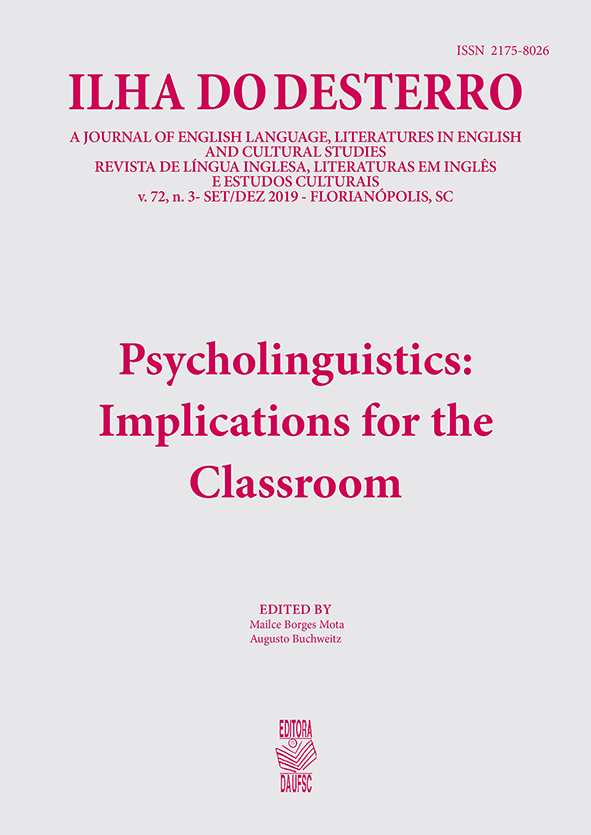When knowing a grammar rule makes L2 users non-native-like
DOI:
https://doi.org/10.5007/2175-8026.2019v72n3p359Abstract
In this work, we investigate the effects of transfer of training in late Brazilian Portuguese-English bilinguals, compared to natives, in relation to their processing of the English causative-have construction. Two experiments were conducted: one focused on the comprehension of the pattern, and the other focused on its production. The results of both experiments point to the fact that the grammatical rule learned by bilinguals is only 'transferred' when there is time to implement it. In the first experiment, we found no effect of training, on the contrary, bilinguals might have been affected by the SVO distribution of the corresponding construction in their L1. In the second experiment, however, we found that bilinguals had high rates of usage of the canonical causative-have form, SAuxOV. This behavior indicates that bilinguals do not implement the rule automatically. Rather, its implementation is seen in more controlled tasks. Thus, explicitly given grammatical rules seem not to be implicitly learned, as they are not automatized to be easily retrieved in real life usage. Moreover, concerning the causative-have rule, bilinguals' linguistic behavior was more similar to that of natives' when they did not implement the rule and used the SVO form with a causative sense.References
Alexander, L. (1990). Longman English grammar practice. London New York: Longman.
Azar, B. & Hagen, S. (2009). Understanding and using English grammar. White Plains, N.Y: Pearson Education.
Davies, Mark. (2008-) The Corpus of Contemporary American English (COCA): 560 million words, 1990-present. Available online at https://corpus.byu.edu/coca/.
Dulay, H. C., & Burt, M. K. (1973). Should we teach children syntax?. Language learning, 23(2), 245-258.
Dulay, H. C., & Burt, M. K. (1974). NATURAL SEQUENCES IN CHILD SECOND LANGUAGE ACQUISITION 1. Language learning, 24(1), 37-53.
Ellis, N. C. (2006). Selective attention and transfer phenomena in L2 acquisition: Contingency, cue competition, salience, interference, overshadowing, blocking, and perceptual learning. Applied Linguistics, 27(2), 164-194.
Ellis, N. C. (2008). The dynamics of second language emergence: Cycles of language use, language change, and language acquisition. The modern language journal, 92(2), 232-249.
Goldberg, A. E. (1995). Constructions: A construction grammar approach to argument structure. University of Chicago Press.
Goldberg, A. E. (2006). Constructions at work: The nature of generalization in language. Oxford University Press on Demand.
Krashen, S. (1994). The input hypothesis and its rivals. Implicit and explicit learning of languages, 45-77.
McCarthy, M., McCarten, J. & Sandiford, H. (2014). Touchstone. New York: Cambridge University Press.
Murphy, R. & Murphy, R. (2015). English grammar in use : a self-study reference and practice book for intermediate learners students of English. Cambridge: Cambridge University Press
Nassaji, H. (2017). Grammar acquisition. The Routledge handbook of instructed second language acquisition, 205-223.
Nation, I. S. P. (1990). Teaching and Learning Vocabulary. Teaching Methods. United States: Cengage Learning, Inc. Retrieved September, 9, 2017.
Nemser, W. (1971). Approximative systems of foreign language learners. IRAL-International Review of Applied Linguistics in Language Teaching, 9(2), 115-124.
Robinson, P., Mackey, A., Gass, S. M., & Schmidt, R. (2012). Attention and awareness in second language acquisition. The Routledge handbook of second language acquisition, 247-267.
Schmidt, R. (2010). Attention, awareness, and individual differences in language learning. In W. M. Chan, S. Chi, K. N. Cin, J. Istanto, M. Nagami, J. W. Sew, T. Suthiwan, & I. Walker, Proceedings of CLaSIC 2010, Singapore, December 2-4 (pp. 721-737). Singapore: National University of Singapore, Centre for Language Studies.
Segalowitz, N. (2010). Cognitive bases of second language fluency. Routledge.
Selinker, L. (1972). Interlanguage. IRAL-International Review of Applied Linguistics in Language Teaching, 10(1-4), 209-232.
Slabakova, R. (2014). The bottleneck of second language acquisition. Foreign Language Teaching and Research, 46(4), 543-559.
Sorace, A. (2011). Pinning down the concept of “interface” in bilingualism. Linguistic approaches to bilingualism, 1(1), 1-33.
Ullman, M. T. (2001). The neural basis of lexicon and grammar in first and second language: The declarative/procedural model. Bilingualism: Language and cognition, 4(2), 105-122.
Vilela, A.C. (2009). Transferência Linguística e Transferência de Treinamento na In- terlíngua do Falante de Português-L1 / Inglês-L2. (Master’s Thesis) . Retrieved from http://www.poslin.letras.ufmg.br/defesas/1239M.pdf.
Westney, P. (1994). Rules and pedagogical grammar. Perspectives on pedagogical grammar, 72-96.
Winter, B., & Reber, A. S. (1994). Implicit learning and the acquisition of natural languages. Implicit and explicit learning of languages, 115-145.




